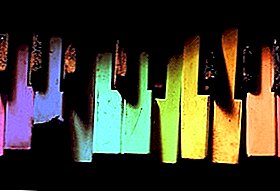 Even in ancient India, there were peculiar ideas about the close relationship between music and color. In particular, the Indians believed that each person has his own melody and color. Ingenious Aristotle argued in the treatise "On the Soul" that the ratio of colors is like musical harmonies.
Even in ancient India, there were peculiar ideas about the close relationship between music and color. In particular, the Indians believed that each person has his own melody and color. Ingenious Aristotle argued in the treatise "On the Soul" that the ratio of colors is like musical harmonies.
The Pythagoreans preferred the white color, as the main one in the Universe, and the colors of the spectrum in their presentation corresponded to seven musical tones. The colors and sounds in the cosmogony of the Greeks are active creative forces.
In the 18th century, monk scientist L. Castel decided to construct a "color harpsichord." Pressing the key would give the listener a bright color spot in a special window above the tool in the form of a color moving tape, checkboxes, precious stones shining with different colors, highlighted with torches or candles to enhance the effect.
The composers Rameau, Telemann and Grétry took a close look at Castel’s ideas. At the same time, he was sharply criticized by encyclopedists, who considered the analogy of the “seven sounds of a scale - the seven colors of the spectrum” untenable.
The phenomenon of "color" hearing
The phenomenon of the color vision of music was discovered by some outstanding musical figures. The genius Russian composer N.A. Rimsky-Korsakov, famous Soviet musicians B.V. Asafiev, S.S. Skrebkov, A.A. Kenel, and others. All the tonalities of the major and minor were seen painted in certain colors. Austrian composer of the 20th century A. Schönberg compared colors with the musical timbres of the symphony orchestra instruments. Each of these outstanding masters saw their colors in the sounds of music.
- For example, for Rimsky-Korsakov D major had a golden hue and caused a feeling of joy and light, for Asafiev, he painted in the color of emerald green lawn after a spring rain.
- D flat major It seemed to Rimsky-Korsakov darkish and warm, Kenel - lemon yellow, Asafiev - a red glow, and in Skrebkov he caused associations with green.
But there have been amazing coincidences.
- About tonality E major expressed as the blue color of the night sky.
- D major in association with Rimsky-Korsakov with a yellowish, regal color, with Asafiev - this is the sun's rays, intense hot light, and with Skrebkov and Kenel - yellow.
It is worth noting that all these musicians had absolute pitch.
"Color painting" sounds
Works N.A. Rimsky-Korsakov musicologists are often called "sound painting." Such a definition is associated with the marvelous pictorial music of the composer. The operas and symphonic compositions of Rimsky-Korsakov are full of musical landscapes. The choice of the tonal plan of nature paintings is by no means random.
Seen in blue in E major and E flat major, in the operas The Tale of Tsar Saltan, Sadko, The Golden Cockerel, they are used to create pictures of the sea, the starry night sky. The sunrise in the same operas was written in A major - the spring, pink tonality.
In the opera Snow Maiden, an ice girl appears for the first time on the scene in “blue” E major, and her mother Spring-Krasna appears in “spring, pink” in A major. The manifestation of lyrical feelings was transmitted by the composer in “warm” D flat major - this is also the tonality of the melting scene of the Snow Maiden, who received the great gift of love.
The French Impressionist composer C. Debussy did not leave precise statements about his vision of music in color. But his piano preludes - “The Terrace Visited by Moonlight”, in which sound reflections shimmer, “Girl with Flaxen Hair”, written in subtle watercolor tones, suggest that the composer had clear intentions to combine sound, light and color.
Debussy's symphonic work Nocturnes allows you to clearly feel this unique light-color-sound. The first part - "Clouds" draws slowly moving and fading away silver-gray clouds. The second Nocturne "Celebration" depicts the light bursts of the atmosphere, its fantastic dance. In the third nocturne on the waves of the sea, sparkling in the night air, magical maiden sirens sway and sing their bewitching song.
Speaking of music and color, it is impossible not to touch the creativity of the genius A.N. Scriabin. For example, he clearly felt the thick red color of F major, the golden - D major, the blue solemn gave F sharp major. In Scriabin, not all tonalities were associated with any color. The composer created an artificial sound-color system (C major - red, G major - in orange, and D major - in yellow tones and further - by the fifth circle and color spectrum). The composer’s ideas about the combination of music, light and color in the symphonic poem "Prometheus" were most clearly embodied.
Scientists, musicians and artists today argue about the possibility of combining color and music. There are studies that the periods of oscillations of sound and light waves do not coincide, and “color sound” is only a perception phenomenon. But there are definitions among musicians: "tonal color", "timbre paint". And if sound and color are combined in the creative consciousness of the composer, then the grandiose “Prometheus” A. Scriabin and the majestic sounding landscapes of I. Levitan, N. Roerich are born. In Polenova ...

Leave Your Comment